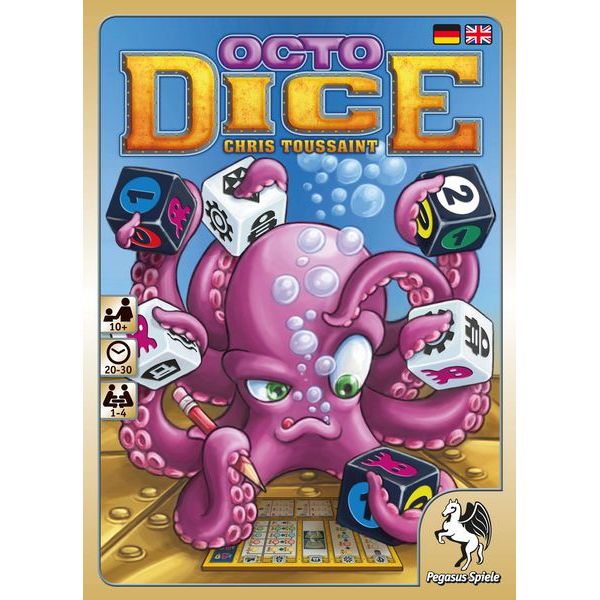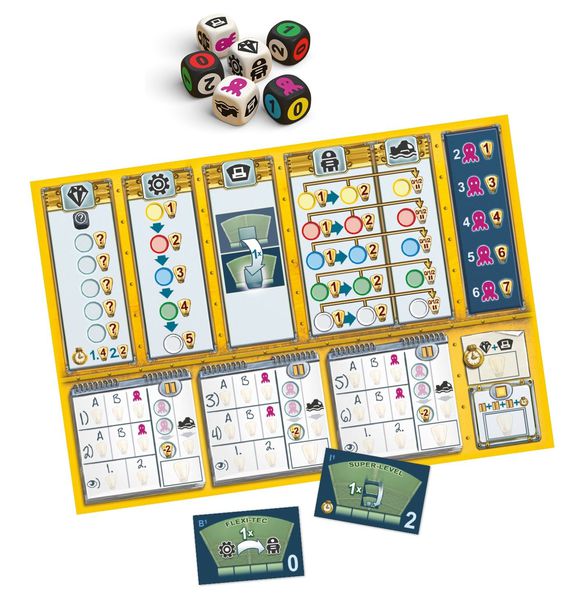Enjoy an Oceanic Roll and Write with OctoDice

Dive into the ocean, in this roll and write game full of octopods and submarines. Improve your lab and analyze crystals, but tread carefully because your opponents will benefit from your dice rolls as well!
OctoDice has a neat theme, and keeps players involved each turn by allowing them to borrow their opponents' actions. If you enjoy roll and write games, this is one you might want to check out.
Gameplay
Each game of OctoDice is split into thirds. Some scoring is done at the end of each third. Each third has two rounds in it and every round, each player gets one turn.
In the center of the table are three columns of lab tiles, with each column having three tiles in it numbered zero to two. Each player places one of their colored cubes above each of the zero marked tiles at the top of each column. Every player than takes a scoring sheet.
On your turn you roll the six six-sided dice. Three dice are white and show different types of actions and three dice are black and show both a number and a color. After you roll, you must set aside exactly two dice. You roll again, set aside two more, and then roll one final time. You may then take up to two actions that you have the proper dice for.
There are five main actions to choose from. Analyzing crystals allows you to cross out one of the circles in the crystal column of your score sheet and score points equal to the number on the black die you used for this action. When you take the research action, you mark off the circle (whose color matches the black die you are using), in your research column on your sheet and score the points shown next to the circle you've filled in. However, research circles must be checked off in a certain order. You cannot fill in the blue circle before the red for example.
When taking the bot action, you check off the matching colored bot circle, and score the number of points shown next to it. Each color of robot has two circles and a connecting submarine circle. When you take a submarine action, you may fill in this circle, and it will score you points after each third of the game, if one or both of matching colored bots are also filled in.
Finally, when you take the lab action, you may move your player cube down on one of the three lab columns; however the number on the black die you use must match the number on the lab tile you are moving your cube onto. Each lab tile also grants you a special ability you can use during the game or extra points.
After you have finished taking actions, you mark if you have any dice showing octopods, and check them on your sheet. If you have two or more at the end of your turn, you score extra points. You must check at least two octopods for each third of the game or you will lose two points.
On your turn, players may use your dice to take actions. During each third, up to two times, you may choose to use any two dice an opponent has rolled on their turn to take a legal action. You may not do this twice in one turn.
At the end of the game, bonus points are awarded for the first and second most crystals filled in on a sheet. The player with the most points wins the game.

Review
OctoDice offers players multiple actions to choose between on each turn, but keeps things simple with a neatly designed player scoresheet. The scoresheet not only makes it easy to keep track of each action type and your progress on it, but also turns, rounds, and your score at any given moment.
The lab tiles are double-sided and can be randomized each game to keep things fresh, and their abilities can offer you extra points for specific actions, giving you reason to adjust your strategy as you progress, or ways to manipulate your dice rolls. While the lab tiles add variety, however, they also significantly increase the learning curve of the game, since players will have to learn what abilities each of the nine tiles offer.
Matching the white and the black dice to perform actions also gives you some flexibility as you set dice aside after each roll and allows you to hedge your bets while also offering you some difficult decisions. The game can also be played two players, with only minimal tweaking and should feel just as satisfying as a three or four player game. The solo mode is also enjoyable.
Regarding the components, the game could use some improvements. Some of the artwork is less than inspired, particular the lab tiles. The cover has fun artwork, although it appears pixelated. The wooden dice included with the game have several irregularities (chips and odd shapes), and the purple paint of the octopods is hardly visible on the black dice.
Overall, if you enjoy dice games or roll and writes, OctoDice is an enjoyable member of the genre. It plays fast, players may take actions during opponents' turns, and the writing aspect is particularly well implemented with the player sheets.
Pros: Player sheets are well designed, lab tiles can be randomized, fun with two players
Cons: Component quality could be improved







